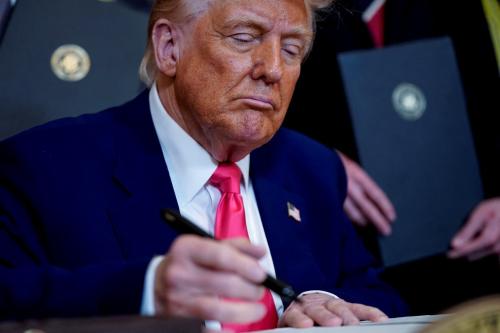In Unpacked, Brookings experts provide analysis of Trump administration policies and news.
THE ISSUE: Improving U.S. infrastructure was a major talking point during the 2016 election, and remains a focus of the administration and the media. Despite discussion around a broad infrastructure bill, the reality of how government addresses and finances infrastructure projects would make a single executable action nearly impossible, leaving the future of infrastructure investment uncertain.
We’re left with a system where Americans are asking for an infrastructure bill, but they should not expect to see one any time in the near future.
THE THINGS YOU NEED TO KNOW
- Infrastructure played a major role in the 2016 election, and for good reason. America’s built environment is struggling in many ways.
- One reason is because Americans are driving more than ever: after a dip during the Great Recession they’ve put more than three trillion miles on U.S. roads.
- Public transportation agencies are also investing in more buses, trains, and other transportation needs, which is adding to the strain on infrastructure.
- U.S. freight networks, for example are now moving more than 20 trillion dollars worth of goods including everything from coal and agricultural products to consumer goods—and about 80 percent of this freight moves along just 10 percent of trade corridors in the U.S.
- We’re also seeing significant investment needs in our water infrastructure. Municipal water agencies need about 600 billion dollars in investment, but only 17 percent think that they have the capacity to actually make these investments.
- While the need to invest in infrastructure is clear, the “infrastructure bill” that was touted during the campaign and that’s top of mind in Washington and in the national media is a common misnomer.
- Infrastructure legislation is discussed as some kind of singular action to execute, but that doesn’t align with the way the federal government is set up.
- In reality, the government is designed to address infrastructure in different sectors via multiple congressional committees and executive agencies built around the same silos.
- Bringing people from these different committees together to agree on an infrastructure project would be extremely difficult, and even if that happened, there’s still the issue of financing.
- Funding sources are essentially nonexistent, and even Trump’s proposed infrastructure tax credit is facing opposition from rural senators, leaving few financing options.
- We’re left with a system where Americans are asking for an infrastructure bill, but they should not expect to see one any time in the near future.
THE SOURCES
Short- and long-term strategies to renew American infrastructure
Infrastructure skills: Knowledge, tools, and training to increase opportunity
The Brookings Institution is committed to quality, independence, and impact.
We are supported by a diverse array of funders. In line with our values and policies, each Brookings publication represents the sole views of its author(s).




Commentary
Investing in infrastructure
March 30, 2017